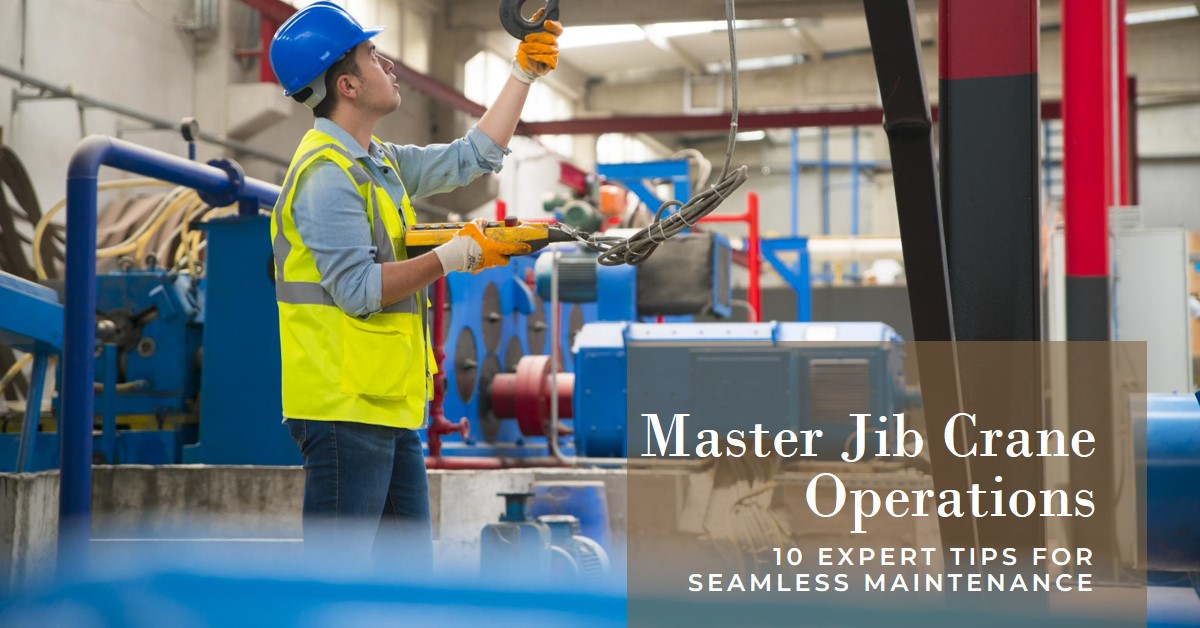Jib cranes, also known affectionately as swing jibs, stand as indispensable workhorses in a multitude of industries. These trusty contraptions excel in effortlessly hoisting and maneuvering hefty loads with pinpoint accuracy and efficiency. Whether stationed in bustling warehouses, bustling manufacturing plants, dynamic construction sites, or bustling shipyards, their adaptability and reliability make them cherished assets across diverse work settings. Yet, to truly unlock the boundless potential of these mechanical marvels, one must possess a keen understanding of both their operation and maintenance. In this all-encompassing guide, we embark on a journey through 10 expert tips thoughtfully curated to aid you in mastering the art of Jib Crane Mastery, thus ensuring uninterrupted operations and meticulous maintenance with a touch of human-friendly flair.
Table of Contents
Understanding Jib Cranes: A Brief Overview
Before we jump into the nitty-gritty details, let’s take a friendly stroll through the fascinating world of jib cranes. Picture this: a jib crane is like your trusty helping hand in the world of heavy lifting. It’s made up of a cool horizontal arm called the “jib” that swings gracefully on a vertical support structure. This design isn’t just for show—it gives the crane an incredible range of motion. Imagine it like your arm swinging from side to side but on a much larger scale! This flexibility allows the crane to lift and move hefty loads within its designated area, kind of like your own personal superhero lifting heavy objects effortlessly.

Now, here’s where it gets interesting: jib cranes come in all shapes and sizes! You’ve got your wall-mounted ones, your floor-mounted ones, and even freestanding models. It’s like choosing the perfect tool for the job—each type is tailored to meet specific needs and fit into different spaces. Whether it’s snugly attached to a wall, firmly rooted to the ground, or standing tall on its own, there’s a jib crane out there ready to tackle any lifting challenge with style and ease.
Tip 1: Conduct Regular Inspections
Now, this step is absolutely crucial for keeping your jib crane in tip-top shape and ensuring it operates safely and smoothly. Think of it like giving your car a regular check-up to catch any issues before they turn into big problems.
First off, start by taking a good look at your crane. Check for any obvious signs of wear and tear, damage, or pesky corrosion. Give it a once-over, paying special attention to key components like the hoist mechanism, cables, hooks, and electrical systems. It’s like giving your crane a thorough spa treatment—making sure every part is in prime condition.
But we’re not done yet! Next up, it’s time for some functional tests. Think of it as putting your crane through its paces to make sure it’s firing on all cylinders. Move those parts around and see how they behave. Are they gliding smoothly like a well-oiled machine? Or are they squeaking and stuttering like a rusty bicycle? By testing everything out, you can catch any issues early on and make sure all those important safety features are doing their job properly.
So, remember folks, regular inspections are like the superhero cape that keeps your crane flying high and mighty. Give it the attention it deserves, and it’ll reward you with safe and optimal performance every time.
Tip 2: Train Operators Effectively
Now, just like driving a car or flying a plane, operating a jib crane requires skill, knowledge, and a whole lot of training. It’s like being the captain of your own ship—you need to know the ropes (pun intended) to navigate safely and efficiently.
So, how do you ensure your crane operators are up to the task? It all starts with providing top-notch training programs. Think of it as giving them the keys to success—a comprehensive guide to mastering the art of crane operation. These programs should cover everything from the basics of crane operation to advanced load-handling techniques, safety protocols, and emergency procedures. It’s like giving them a crash course in crane command—equipping them with the knowledge and skills they need to tackle any situation with confidence.
But it’s not just about learning the ropes (there’s that pun again). It’s also about understanding the importance of safety and responsibility. That means emphasizing the need to stick to operational limits, steer clear of overloading, and maintain clear communication with ground personnel. It’s like teaching them the rules of the road—making sure they know how to navigate safely and avoid any potential hazards along the way.
And just like any skill, crane operation requires practice and reinforcement. That’s why regular refresher courses and competency assessments are essential. It’s like sharpening your sword to keep it battle-ready—you need to keep honing those skills to stay at the top of your game.
So, to sum it up, effective training is the key to ensuring your crane operators are ready for anything. By providing comprehensive programs, emphasizing safety and responsibility, and offering regular reinforcement, you can empower them to operate with confidence and skill, keeping your operations running smoothly and safely around the clock.
Tip 3: Follow Manufacturer’s Guidelines
Now, imagine you’re embarking on a new adventure with your jib crane. Just like setting off on a journey with a trusty map, you need to follow the manufacturer’s guidelines to ensure you reach your destination safely and successfully.
First things first, consult the crane’s manual—it’s like your roadmap for navigating the world of crane operation. This manual is chock-full of valuable information, from step-by-step instructions on installation and operation to handy tips for maintenance and troubleshooting. It’s like having a seasoned guide by your side, helping you navigate through every twist and turn of crane ownership.
But here’s the thing: pay close attention to every detail in that manual. It’s not just a bunch of boring technical jargon—it’s your ticket to safety and efficiency. Take note of important factors like load capacities, operational limits, inspection intervals, and recommended spare parts. It’s like having the key to a treasure trove of knowledge—knowing these details can mean the difference between smooth sailing and running into trouble.
Now, why is it so important to stick to these guidelines? Well, think of it this way: deviating from the manufacturer’s recommendations is like wandering off the beaten path in the wilderness. Sure, it might seem like a shortcut at first, but it could lead to all sorts of problems down the line. From compromising safety to voiding warranties and even facing costly repairs or accidents, straying from the guidelines is a risky move you’ll want to avoid at all costs.
So, remember folks, when it comes to operating your jib crane, stick to the script. Follow the manufacturer’s guidelines to the letter, and you’ll enjoy smooth sailing on your crane journey, free from any unexpected detours or pitfalls.
Tip 4: Implement Preventive Maintenance
Picture your jib crane as a well-oiled machine—it’s sturdy, reliable, and ready to tackle any lifting task. But just like any machine, it needs a little TLC to keep it running smoothly for years to come.
That’s where preventive maintenance comes in. Think of it as giving your crane a regular check-up—a little love and attention to keep it in peak condition. By developing a proactive maintenance schedule, you’re essentially creating a roadmap for keeping your crane in tip-top shape.
So, what does this maintenance schedule entail? Well, it’s like a checklist of tasks designed to keep your crane humming along like a well-oiled machine. Start by lubricating those moving parts to ensure they glide effortlessly. Check those electrical connections to make sure everything’s in working order. Adjust those brakes to ensure smooth and safe operation. And don’t forget to replace any worn-out components to prevent them from causing bigger problems down the line.
But here’s the kicker: it’s not just about doing the maintenance—it’s also about keeping detailed records of everything you do. Think of it as creating a journal for your crane—logging every inspection, every adjustment, and every replacement. By keeping track of these activities, you’re not only ensuring that your crane stays in top-notch condition, but you’re also demonstrating compliance with regulatory requirements. It’s like having a paper trail that proves you’re taking good care of your crane and keeping it safe and reliable.
So, to sum it up, preventive maintenance is like giving your crane a little love and attention to keep it running smoothly. By developing a proactive maintenance schedule, staying on top of routine tasks, and keeping detailed records, you can extend the lifespan of your crane, minimize unexpected downtime, and ensure safe and reliable operation for years to come.
Tip 5: Monitor Load Capacities
Imagine your jib crane as a superhero, capable of lifting heavy loads with ease. But even superheroes have limits, and exceeding those limits can lead to disastrous consequences.
That’s why it’s crucial to keep a close eye on the load capacity of your crane. Think of it as knowing the maximum weight your superhero can lift without breaking a sweat. Before hoisting any load, it’s essential to verify its weight and ensure that it falls within the crane’s rated capacity. It’s like checking the weight limit on a sign before stepping onto an elevator—making sure you’re not pushing it past its limits.
But how do you know the weight of the load? Well, that’s where calibrated weighing scales or load cells come into play. These handy tools provide accurate measurements, ensuring you’re not overloading your crane. It’s like having a trusty sidekick who can double-check your calculations and keep you from making any costly mistakes.
Now, here’s the thing: it’s not just about the weight of the load. You also need to consider factors like load distribution, dynamic loading, and environmental conditions. It’s like taking into account the wind and weather before setting sail on a boat—you want to make sure everything’s in balance and that you’re prepared for whatever challenges may arise.
So, to sum it up, monitoring load capacities is like keeping your superhero crane in check—making sure it’s not taking on more than it can handle. By verifying the weight of the load, using the right tools for the job, and considering all relevant factors, you can ensure safe and efficient lifting operations, protecting both your crane and your personnel from harm.
Tip 6: Practice Safe Load Handling
Imagine you’re lifting a heavy object with your jib crane—it’s like orchestrating a delicate ballet, with every move carefully choreographed to ensure a flawless performance. But just like in ballet, safety is paramount, and practicing safe load handling is crucial to preventing accidents and protecting both personnel and property.
First things first, it’s essential to use the right lifting accessories. Think of them as your trusty tools of the trade—slings, hooks, chains—they’re like your partners in crime, helping you lift with ease and precision. But here’s the catch: they need to be properly secured to the load. It’s like making sure your shoelaces are tied tight before hitting the dance floor—you don’t want anything coming loose mid-performance.
Next up, it’s all about smooth movements. Avoid sudden jerks or movements during lifting and lowering operations. It’s like dancing with a partner—you want everything to flow seamlessly, without any jarring movements that could throw off your rhythm. By keeping things steady and controlled, you can minimize the risk of load swing or instability, ensuring a safe and successful lift every time.
And let’s not forget about maintaining a safe distance. Just like in any dance, you need to give yourself plenty of space to move without bumping into anything—or anyone. Keep a safe distance from the load and surrounding obstacles to prevent collisions or entanglements. It’s like creating a buffer zone to ensure everyone stays safe and sound.
So, to sum it up, practicing safe load handling is like executing a flawless dance routine—it requires precision, control, and attention to detail. By using the right lifting accessories, avoiding sudden movements, and maintaining a safe distance, you can ensure that every lift is a safe and successful one, protecting both your crane and your personnel from harm.

MORE INFORMATION
Tip 7: Monitor Environmental Conditions
Imagine your jib crane as a seasoned adventurer, navigating through ever-changing landscapes and weather conditions. Just like any intrepid explorer, your crane must be equipped to handle whatever nature throws its way.
First and foremost, it’s crucial to keep a close eye on the weather. Think of it as checking the forecast before embarking on a journey—you want to know what you’re up against. Monitor factors like wind speed, temperature, and humidity, as they can all have a significant impact on the performance and safety of your crane.
Now, here’s where it gets interesting: when conditions take a turn for the worse, it’s essential to take appropriate precautions. Imagine you’re navigating through a storm—you’d want to batten down the hatches and ride it out safely. Similarly, when adverse weather strikes, consider suspending crane operations altogether. It’s like pressing pause on your adventure until the storm passes, ensuring the safety of both your crane and your personnel.
But sometimes, you may need to soldier on despite the weather. In those cases, implementing additional safety measures is key. Think of it as gearing up for battle—you want to be prepared for anything. Consider imposing wind speed restrictions or adjusting load capacities to account for the challenging conditions. It’s like putting on your armor to protect yourself from harm, ensuring that your crane can weather the storm and emerge unscathed.
So, to sum it up, monitoring environmental conditions is like being a savvy navigator, steering your crane through the highs and lows of Mother Nature. By staying vigilant, taking appropriate precautions, and implementing additional safety measures when necessary, you can ensure that your crane remains safe and reliable, no matter what challenges lie ahead.
Tip 8: Inspect Electrical Systems
Imagine the electrical components of your jib crane as the beating heart of its operation—they’re what keeps everything running smoothly and safely. Just like a well-maintained engine in a car, these electrical systems require regular attention to ensure they’re in top-notch condition.
First off, it’s crucial to conduct regular inspections of all electrical components. Think of it as giving your crane’s electrical system a thorough check-up—making sure everything is in working order and free from any potential issues. Inspect the wiring, switches, controls, and electrical connections for any signs of wear, damage, or overheating. It’s like examining the wiring in your home to ensure it’s safe and secure.
But it’s not just about spotting problems—it’s also about taking preventive measures to keep your electrical system in good shape. Ensure that all electrical systems are properly grounded, insulated, and protected from moisture and contaminants. It’s like putting on a raincoat to shield yourself from the elements—protecting your electrical components from the potential damage caused by water or dirt.
And let’s not forget about testing and maintenance. Just like changing the oil in your car or getting a tune-up, periodic testing and maintenance of electrical components are essential for ensuring their continued reliability and safety. It’s like giving your crane’s electrical system a regular tune-up—keeping everything running smoothly and preventing any potential breakdowns.
So, to sum it up, inspecting electrical systems is like taking care of the heart of your jib crane. By conducting regular inspections, taking preventive measures, and performing routine testing and maintenance, you can ensure that your crane’s electrical components continue to operate safely and reliably, keeping your operations running smoothly around the clock.
Tip 9: Address Wear and Tear Promptly
Imagine your jib crane as a trusty companion on a rugged journey—it’s been through thick and thin, weathering the storms and conquering the challenges along the way. But just like any seasoned traveler, your crane is bound to show signs of wear and tear over time.
First things first, it’s crucial to keep a close eye on your crane’s condition. Think of it as checking in on your faithful friend—making sure they’re holding up okay despite the wear and tear of the journey. Keep a keen eye out for any signs of wear, corrosion, or deterioration. Whether it’s a frayed cable, a rusty bearing, or a worn-out gear, addressing these issues promptly is essential to maintaining your crane’s performance and safety.
But here’s the kicker: don’t wait until things get out of hand. Just like fixing a leaky roof before it becomes a flood, addressing wear and tear promptly can prevent bigger problems down the line. Replace worn-out components before they compromise your crane’s performance or safety. It’s like changing the tires on your car before they blow out on the highway—taking proactive measures to ensure smooth sailing ahead.
Now, here’s where it gets interesting: consider implementing a proactive replacement schedule for critical wear parts. Think of it as creating a maintenance roadmap for your crane—knowing exactly when to replace those worn-out components to minimize downtime and maintenance costs. By staying one step ahead of wear and tear, you can keep your crane running smoothly and efficiently, ensuring it remains a reliable companion on your journey for years to come.
So, to sum it up, addressing wear and tear promptly is like taking care of your crane’s well-being—it’s about keeping it strong and resilient despite the challenges it faces along the way. By monitoring its condition closely, replacing worn-out components promptly, and implementing a proactive replacement schedule, you can ensure that your crane continues to serve you faithfully, day in and day out, no matter where your journey takes you.
Tip 10: Document Maintenance Activities
Imagine your maintenance records as the diary of your jib crane—it’s like keeping track of its health and well-being over time. Just like keeping track of your own health history, these records are invaluable for understanding your crane’s performance, identifying any issues, and ensuring compliance with regulations.
First and foremost, it’s crucial to keep comprehensive maintenance logs. Think of it as jotting down notes in a journal—documenting every inspection, repair, replacement, and upgrade. These logs provide a detailed record of your crane’s maintenance history, allowing you to track its condition and performance over time.
But it’s not just about recording what you’ve done—it’s also about why you’ve done it. Note any deviations from the manufacturer’s guidelines or regulatory requirements, and the rationale behind them. It’s like explaining your reasoning to a doctor during a check-up—providing context for your actions and decisions.
Now, here’s where it gets interesting: these records aren’t just for your own benefit. They also serve as a valuable tool for identifying trends and anticipating maintenance needs. It’s like spotting patterns in your own health history—recognizing when certain issues tend to crop up and taking proactive measures to address them.
And let’s not forget about compliance. These records are like your passport to prove that you’ve been following the rules. Use them to demonstrate compliance with applicable standards during inspections or audits, showing that you’ve been diligent in maintaining your crane and keeping it safe and reliable.
So, to sum it up, documenting maintenance activities is like keeping a diary for your crane—it’s a record of its journey, from its first day on the job to the present. By keeping detailed logs, noting any deviations, and using these records to identify trends and demonstrate compliance, you can ensure that your crane remains in top-notch condition and ready to handle any challenges that come your way.
Conclusion
In conclusion, becoming proficient in the operation and upkeep of jib cranes necessitates a blend of knowledge, expertise, and attentiveness. By heeding the advice provided in these 10 expert tips, you pave the way for smooth operations, heightened efficiency, and heightened safety within your workplace. It’s crucial to prioritize routine inspections, thorough training, preemptive maintenance, and strict adherence to manufacturer’s guidelines to attain mastery in handling jib cranes. Through dedicated investment in proper care and upkeep, you can optimize the functionality and durability of your jib cranes, leading to enhanced productivity and profitability for your business. Moreover, fostering a culture of safety and continuous improvement among your team can further elevate your operations and drive long-term success.


Ive read several just right stuff here Certainly price bookmarking for revisiting I wonder how a lot effort you place to create this kind of great informative website